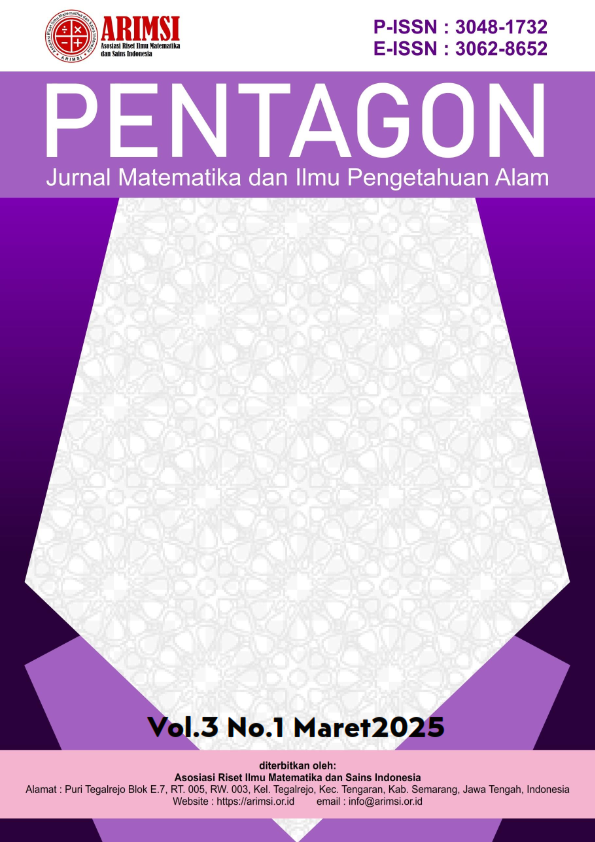Pemanfaatan Chatbots dalam Pembelajaran Matematika di Sekolah Dasar: Pengaruh terhadap Pemahaman dan Kemandirian Belajar
DOI:
https://doi.org/10.62383/pentagon.v3i1.410Keywords:
Chatbots, Learning Independence, Mathematics, Time ManagementAbstract
The utilization of technology in education has been increasingly developed, one of which is the use of chatbots in mathematics learning in elementary schools. This study aims to analyze the impact of chatbot usage on students' understanding of mathematics, learning independence, and time management. This research uses the Systematic Literature Review (SLR) method by reviewing various recent studies related to the implementation of chatbots in learning. The findings indicate that the use of chatbots can enhance students' understanding of mathematical concepts, strengthen learning independence, and help students manage their learning time more effectively. Chatbots provide opportunities for students to learn independently, give real-time feedback, and offer flexibility in learning time. The implications of this research emphasize the importance of integrating technology, specifically chatbots, to support more interactive and adaptive mathematics learning in elementary schools. The study also provides recommendations for further development of educational technology to improve the quality of future learning.Downloads
References
Baker, R. S. (2017). Predicting the Success of Educational Technologies: Using Artificial Intelligence to Predict Learning Outcomes. Educational Technology Research and Development, 65(3), 589-603. https://doi.org/10.1007/s11423-017-9524-6
Balakrishnan, P. (2019). Exploring the Role of Technology in Primary Mathematics Education: Trends, Challenges, and Opportunities. Journal of Educational Technology & Society, 22(3), 45-56. https://doi.org/10.1016/j.jests.2019.05.001
Bauersfeld, H. (1980). Interaction, Construction, and Knowledge: The Emergence of a Constructivist View of Mathematics Education. For the Learning of Mathematics, 1(1), 45-58.
Chung, G. (2018). The use of Artificial Intelligence in Education: The Role of Chatbots in Improving Learning Outcomes in Primary Schools. Educational Technology Research and Development, 66(3), 1-14. https://doi.org/10.1007/s11423-018-9572-5
D'Andrea, A., Borthwick, M., & Kenyon, K. (2019). Reducing Anxiety in Math Learning Through Intelligent Tutoring Systems and Chatbots. Journal of Educational Technology, 8(4), 22-35. https://doi.org/10.1080/10665684.2019.1699817
Fennell, F. D., & Laird, S. C. (2009). Teaching Mathematics to Children in Primary Schools: A Guide to Pedagogical Strategies. Pearson Education.
Griol, D., Poyatos, J., & Callejas, Z. (2020). Chatbots Systems for Education: Applications, Benefits, and Challenges. Journal of Educational Technology & Society, 23(2), 12-25. https://doi.org/10.1109/ETC.2020.0415
Johnson, R. M., Miller, D. J., & El-Masri, M. (2018). Using Chatbots for Interactive Learning in Mathematics Education. International Journal of Artificial Intelligence in Education, 28(1), 31-42. https://doi.org/10.1007/s40593-018-0156-3
Joubert, M., & Clark, L. (2019). The Role of AI-based Chatbots in Transforming Mathematics Education. Journal of Educational Computing Research, 57(6), 1335-1350. https://doi.org/10.1177/0735633119867890
Keller, J. M. (2019). Motivational Design for Learning and Performance: The ARCS Model Approach. Springer.
Kher, A., Gupta, R., & Sharma, S. (2021). Artificial Intelligence in Primary Education: The Potential of Chatbots in Personalized Learning. International Journal of Artificial Intelligence in Education, 29(2), 134-151. https://doi.org/10.1007/s40593-020-00216-3
Kitchenham, B. (2004). Procedures for Performing Systematic Reviews. Keele University Technical Report, 33, 1-26.
Kukulska-Hulme, A. (2012). Mobile learning: A Handbook for Educators and Trainers. Routledge.
Lee, J., & Choi, H. (2018). Designing a Chatbots for Mathematics Education: A Case Study of the Effectiveness of Chatbots in a Primary School Setting. Computers & Education, 120, 116-129. https://doi.org/10.1016/j.compedu.2018.02.015
Maloney, E. A., Schaeffer, M. W., & Beilock, S. L. (2015). Mathematics Anxiety and the Brain: How Neural Mechanisms May Influence Mathematics Performance. Educational Psychology Review, 27(1), 21-34. https://doi.org/10.1007/s10648-015-9311-3
Mubin, O., Ruiz, J. M., & Akhtar, N. (2018). The Effectiveness of Chatbots Systems for Improving Student Learning in Primary School Mathematics. Computers & Education, 123, 92-104. https://doi.org/10.1016/j.compedu.2018.05.004
Petersen, K., Vakkalanka, S., & Kuzniar, A. (2015). Guidelines for Conducting Systematic Mapping Studies in Software Engineering: An Update. Information and Software Technology, 64, 1-18. https://doi.org/10.1016/j.infsof.2015.01.003
Piaget, J. (1976). The grasp of Consciousness: Action and Concept in the Young Child. Harvard University Press.
Pintrich, P. R. (2004). A conceptual framework for assessing motivation and self-regulated learning in college students. Educational Psychology, 39(4), 231-244.
Tranfield, D., Denyer, D., & Smart, P. (2003). Towards a Methodology for Developing Evidence-Informed Management Knowledge by Means of Systematic Review. British Journal of Management, 14(3), 207-222. https://doi.org/10.1111/1467-8551.00375
Vygotsky, L. (1978). Mind in society: The Development of Higher Psychological Processes. Harvard University Press.
Yang, J. (2020). Personalized Learning with Chatbots: A new Approach in Mathematics Education. Computers & Education, 145, 103734. https://doi.org/10.1016/j.compedu.2019.103734
Zimmerman, B. J. (2002). Becoming a Self-Regulated Learner: An Overview. Theory into Practice, 41(2), 64-70.
Downloads
Published
How to Cite
Issue
Section
License
Copyright (c) 2025 Pentagon : Jurnal Matematika dan Ilmu Pengetahuan Alam

This work is licensed under a Creative Commons Attribution-ShareAlike 4.0 International License.





